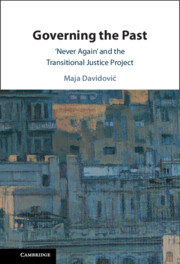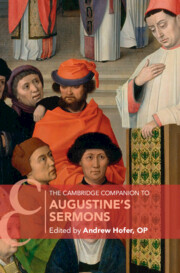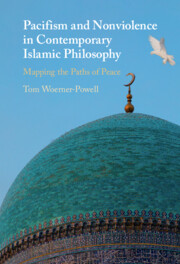Refine search
Actions for selected content:
231 results
Chapter 3 - Hobbes, from War to Leviathan
-
- Book:
- The Social Contract
- Published online:
- 30 May 2025
- Print publication:
- 04 September 2025, pp 29-40
-
- Chapter
- Export citation
Chapter 4 - Hobbes, Toleration, Stability, Government
-
- Book:
- The Social Contract
- Published online:
- 30 May 2025
- Print publication:
- 04 September 2025, pp 41-51
-
- Chapter
- Export citation
17 - Japan and Korea, 1450–1850
-
-
- Book:
- The Cambridge History of War
- Published online:
- 18 July 2025
- Print publication:
- 14 August 2025, pp 430-448
-
- Chapter
- Export citation
1 - Introduction
-
- Book:
- Governing the Past
- Published online:
- 30 July 2025
- Print publication:
- 07 August 2025, pp 4-34
-
- Chapter
-
- You have access
- HTML
- Export citation
Chapter 3 - Absorbing Natural Right into the Kantian System
-
-
- Book:
- Kant's Lectures on Political Philosophy
- Published online:
- 18 July 2025
- Print publication:
- 07 August 2025, pp 48-65
-
- Chapter
- Export citation

Governing the Past
- ‘Never Again' and the Transitional Justice Project
-
- Published online:
- 30 July 2025
- Print publication:
- 07 August 2025

Attention to Virtues
- An Affective Grammar
-
- Published online:
- 25 July 2025
- Print publication:
- 14 August 2025
Data for peace: how novel data sources and technology can enhance peace?
- Part of
-
- Journal:
- Data & Policy / Volume 7 / 2025
- Published online by Cambridge University Press:
- 27 June 2025, e45
-
- Article
-
- You have access
- Open access
- HTML
- Export citation
16 - Preaching on Heaven and Its Peace
- from Part III - Augustine’s Preaching Themes
-
-
- Book:
- The Cambridge Companion to Augustine's Sermons
- Published online:
- 26 May 2025
- Print publication:
- 12 June 2025, pp 299-316
-
- Chapter
- Export citation

The Cambridge Companion to Augustine's Sermons
-
- Published online:
- 26 May 2025
- Print publication:
- 12 June 2025

Protest and Policy in the Iraq, Nuclear Freeze and Vietnam Peace Movements
-
- Published online:
- 19 May 2025
- Print publication:
- 19 June 2025
-
- Element
- Export citation
11 - The Ottoman Encounter and the Law of Nations in the Renaissance
- from Part I - International Law in Renaissance Europe (1492–1660)
-
-
- Book:
- The Cambridge History of International Law
- Published online:
- 22 April 2025
- Print publication:
- 08 May 2025, pp 357-378
-
- Chapter
- Export citation
Interview with Roberto Carlos Vidal López: President of the Special Jurisdiction for Peace in Colombia
-
- Journal:
- International Review of the Red Cross , First View
- Published online by Cambridge University Press:
- 08 May 2025, pp. 1-8
-
- Article
-
- You have access
- Open access
- HTML
- Export citation
Whose Peace? Anti-Military Litigation and the Right to Live in Peace in Postwar Japan
-
- Journal:
- Asia-Pacific Journal / Volume 10 / Issue 29 / July 2012
- Published online by Cambridge University Press:
- 07 May 2025, e1
-
- Article
-
- You have access
- Open access
- Export citation
2 - ‘A Lonely Furrow’
-
- Book:
- The Nehru Years
- Published online:
- 29 April 2025
- Print publication:
- 10 April 2025, pp 10-31
-
- Chapter
- Export citation
“Doing Peace”: Conceptualizing relational peace through interactions and networks in a digitalized world
- Part of
-
- Journal:
- Data & Policy / Volume 7 / 2025
- Published online by Cambridge University Press:
- 02 April 2025, e34
-
- Article
-
- You have access
- Open access
- HTML
- Export citation
Citizen Advocacy: The Achievements of New Zealand's Peace Activism
-
- Journal:
- Asia-Pacific Journal / Volume 17 / Issue 19 / October 2019
- Published online by Cambridge University Press:
- 14 March 2025, e2
-
- Article
-
- You have access
- Open access
- Export citation
Rethinking “Peace” of Hiroshima: Restoring the Subject, and the Logic of “the Only A-bombed Nation”
-
- Journal:
- Asia-Pacific Journal / Volume 21 / Issue 12 / December 2023
- Published online by Cambridge University Press:
- 14 March 2025, e4
-
- Article
-
- You have access
- Open access
- Export citation

Pacifism and Non-Violence in Contemporary Islamic Philosophy
- Mapping the Paths of Peace
-
- Published online:
- 13 March 2025
- Print publication:
- 20 March 2025
-
- Book
-
- You have access
- Open access
- Export citation
5 - War and Peace
-
- Book:
- Exhibitionist Japan
- Published online:
- 06 February 2025
- Print publication:
- 13 February 2025, pp 125-155
-
- Chapter
- Export citation

